Have you ever wondered which is a better method for wiring your surround speakers, and why?
Some installers use Series-Parallel wiring schemes to conserve amp channels and raise load impedance on inferior amps. But at QSC, we have always recommended parallel wiring for all surround speakers when multiple speakers are combined on an amp channel. Parallel connections sound better, are more reliable, provide more dynamic headroom, are easier to wire, and in some cases, make upgrading to 7.1 “free”.
Let me explain:
When a loudspeaker is connected to an amplifier output, the amplifier provides better control of the speaker motion and the speaker has a flatter frequency response if the output impedance of the amplifier is a lot lower than the impedance of the speaker. This is most often specified as the “amplifier damping factor” into 8 ohms, rather than the actual amplifier output impedance. If the amplifier has a damping factor of 250, the output impedance is 8 ohms divided by 250, or 0.032 ohms. With such a low output impedance, the frequency response of the voltage supplied to the speaker is very flat and the amplifier maintains good control over the cone motion at low frequencies.

What’s Wrong with Series?
If a second speaker is placed in series with the first speaker, each speaker is driven by the combined impedance of the amplifier plus the impedance of the other speaker. Instead of a damping factor of 250, it now drops to slightly less than 1, since the new impedance seen by each speaker is 8.032 ohms (the other speaker plus the amplifier output impedance). It gets even lower when speaker cable resistance is added in. The frequency response is affected by any mismatch in the impedance curves of the two speakers.
When two loads are connected in series, the voltage divides across them by the ratio of the load resistance. If both loads are perfectly equal, then the voltage is split equally between the two loads. The problem is that speaker impedance varies greatly with frequency, and no two speakers are exactly the same. This results in unequal sharing of the total voltage, which causes variation in the frequency response of the two speakers. The problem is even more exaggerated in many cinemas when an 8 ohm resistor is used in place of a speaker, as in the case of an odd number of surround speakers, such as 5 speakers per channel.
We can see this in the graph below. The impedance of the SR 1000 surround loudspeaker is in blue and the orange line represents an 8 ohm load resistor.
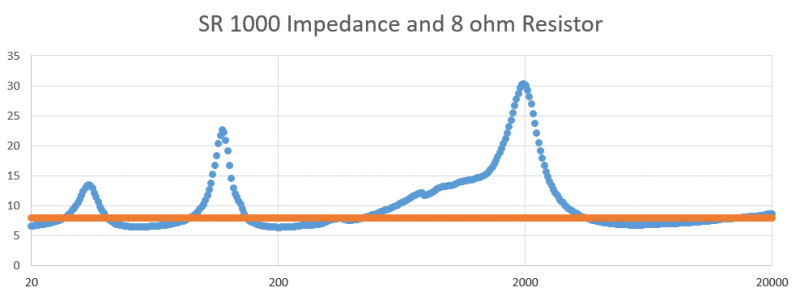
The SR 1000 impedance dips as low as 6.5 ohms at 60 Hz, 200 Hz and 6 kHz. The peak at 2 kHz is just over 30 ohms. If this speaker is connected in series with an 8 ohm resistor, the voltage will only divide equally where the blue curve crosses the orange line at 8 ohms.
With parallel-connected speakers, the same voltage is always applied to all speakers, resulting in better performance and uniform frequency response.
Parallel is More Reliable
Series connected speakers act like the old Christmas lights where when one bulb fails, the entire string goes out. All speakers connected in series will fail if one of the speakers fails. Current cannot pass through a speaker if the speaker is blown or a protection fuse goes open. In a parallel connection, the other speakers continue to operate at the same level as before.
More Dynamic Power and 7.1 for Free
It is common practice to use fewer channels and larger amplifiers for series-parallel connected surround speakers. Let’s take a look at one common example. Assume a cinema uses a 2-channel amplifier to power 12 surround speakers, 6 on each channel. If we connect two speakers in series and then parallel three of these pairs on each channel, we will have three 16-ohm loads in parallel and the amp will see a 5.3-ohm load on each channel. This wiring practice is popular when using amps that cannot handle low impedance loads. However, this is a very easy load for QSC’s DCA 2422 amplifier to drive.
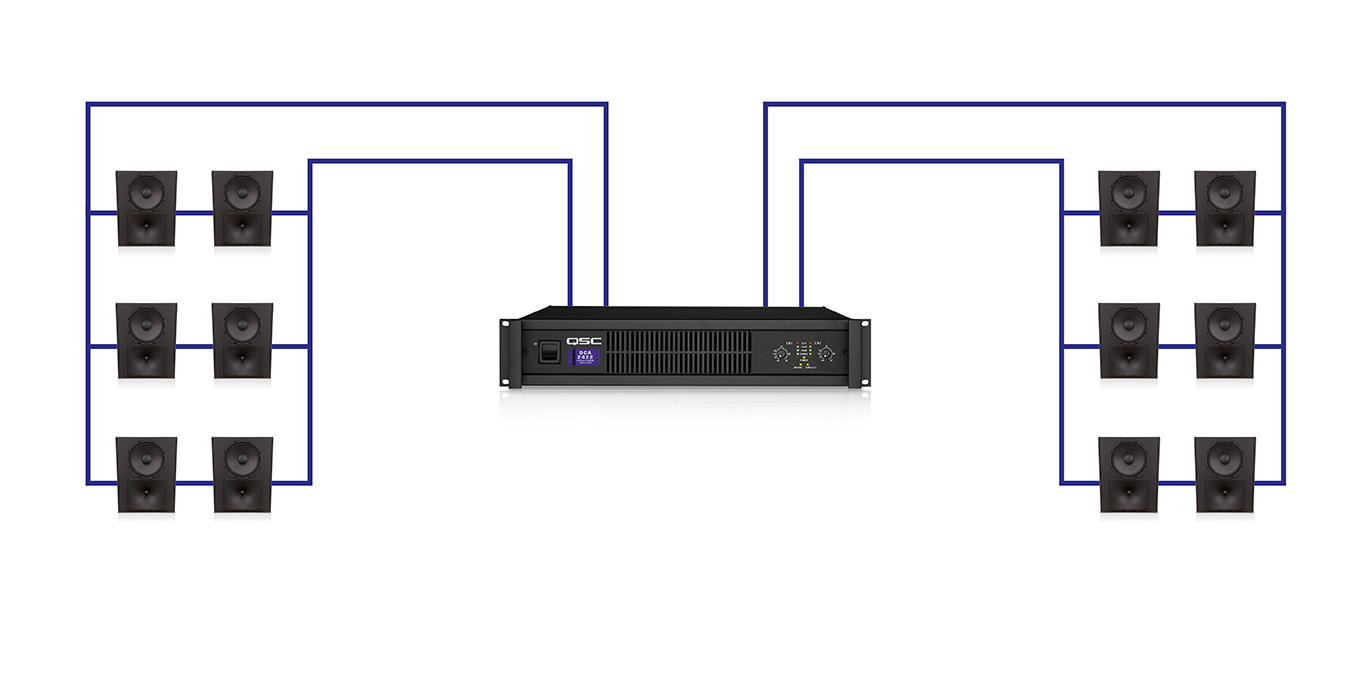
Let’s look at another option using the 4-channel DCA 1824. The DCA 1824 is the same price as the DCA 2422, but having 4-channels gives us more options for configuring the surround speakers. If we want to match the 5.1 configuration of the DCA 2422, we would simply wire three speakers in parallel on each of the four amp channels. This is a 2.67-ohm load per channel, which is fine for the 2-ohm rated DCA 1824. This configuration has the added benefit of allowing for level adjustments between the front and rear of the room if needed.
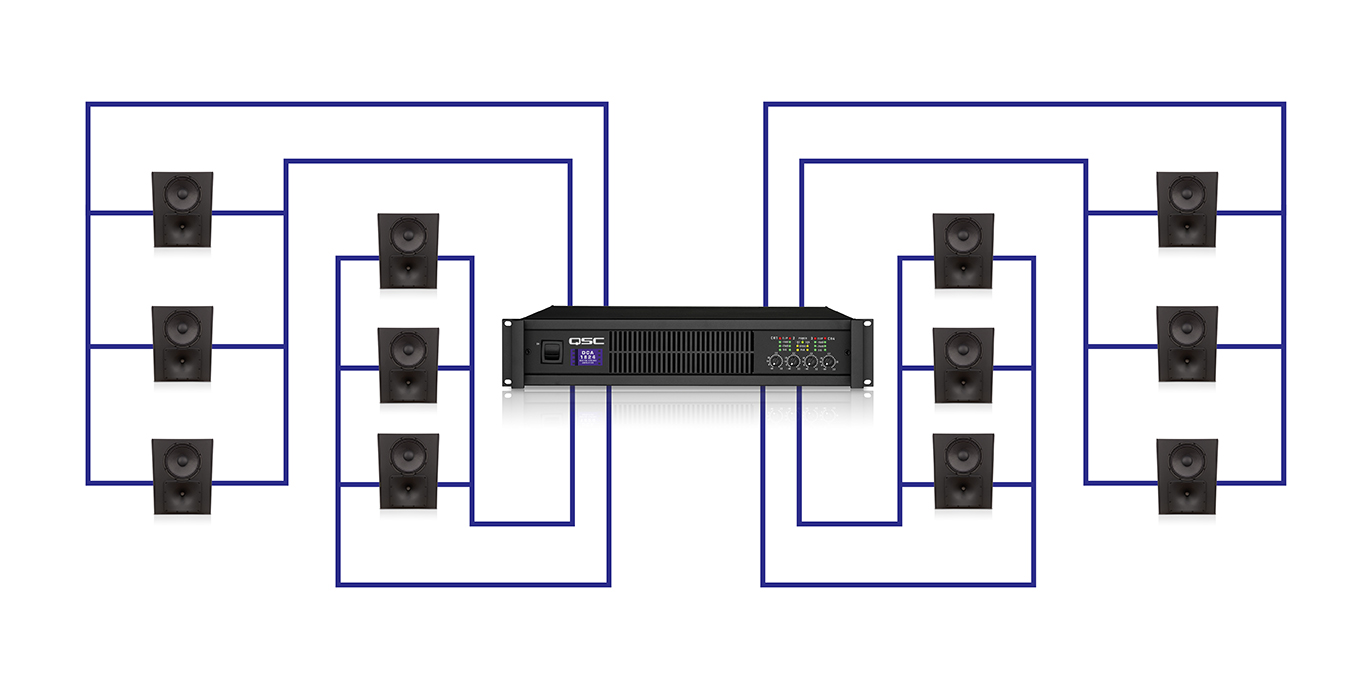
Besides the performance benefits previously discussed, the DCA 1824 option provides greater dynamic power to the surround speakers. Since cinema soundtracks, especially surround channels, have very low average power requirements, the limiting factor on performance is the maximum voltage that can be delivered to each speaker during short-term dynamic peaks in the soundtrack. Peak output voltage from an amplifier is limited by the DC voltage rails of the amplifier power supply, and these rails cannot be exceeded. Let’s take a look at maximum voltage delivered to each speaker in both examples.
The DCA 2422 has a DC rail voltage of +/- 99 Vdc and the DCA 1824 has a DC rail voltage of +/- 67 Vdc. At first glance, the DCA 2422 appears to have the advantage. However, this is not the case. The voltage from the DCA 2422 is split across two series-connected speakers. The most each speaker could receive is a calculated peak of 49.5 volts. The speakers on the DCA 1824 are directly connected to the amplifiers full output voltage and could potentially receive the full 67 volts from the amp. Since amps in the real world can’t exactly reach the full rail voltage, let’s say that the DCA 2422 provides a peak of 48 volts and the DCA 1824 provides a peak of 65 volts to each speaker. Let’s see what the dynamic power capability looks like for each amplifier, and see how large a two-channel amplifier would have to be to give the same performance as the DCA 1824.

The 4-channel DCA 1824 can deliver peaks of 253 watts to an 8-ohm speaker. The 2-channel DCA 2422 delivers only 145W to each speaker. You would have to upgrade to the more powerful 2-channel DCA 3422 to match the dynamic power of the DCA 1824, but that comes with a 25% increase in cost. The DCA 1824 with parallel loads is capable of reproducing peaks that are 2.4 dB louder than the DCA 2422 with a series-parallel connection.
If we change up the DCA 1824 connections a bit, we can have 4 surround channels for 7.1 for the same cost as 5.1. If the room has 4 surrounds on each side wall and 4 on the rear, we can wire the DCA 1824 with four speakers on the Left Side and Right Side channels and two each on Left Back and Right Back. The same peak voltage is applied to each speaker, but the side channels are loaded at 2-ohms, and the rear channels are loaded at 4 ohms. Since QSC DCP and DPM processors have 7.1 capability and the DCA 1824 costs the same as the DCA 2422, this is how you get a 7.1 upgrade for free.
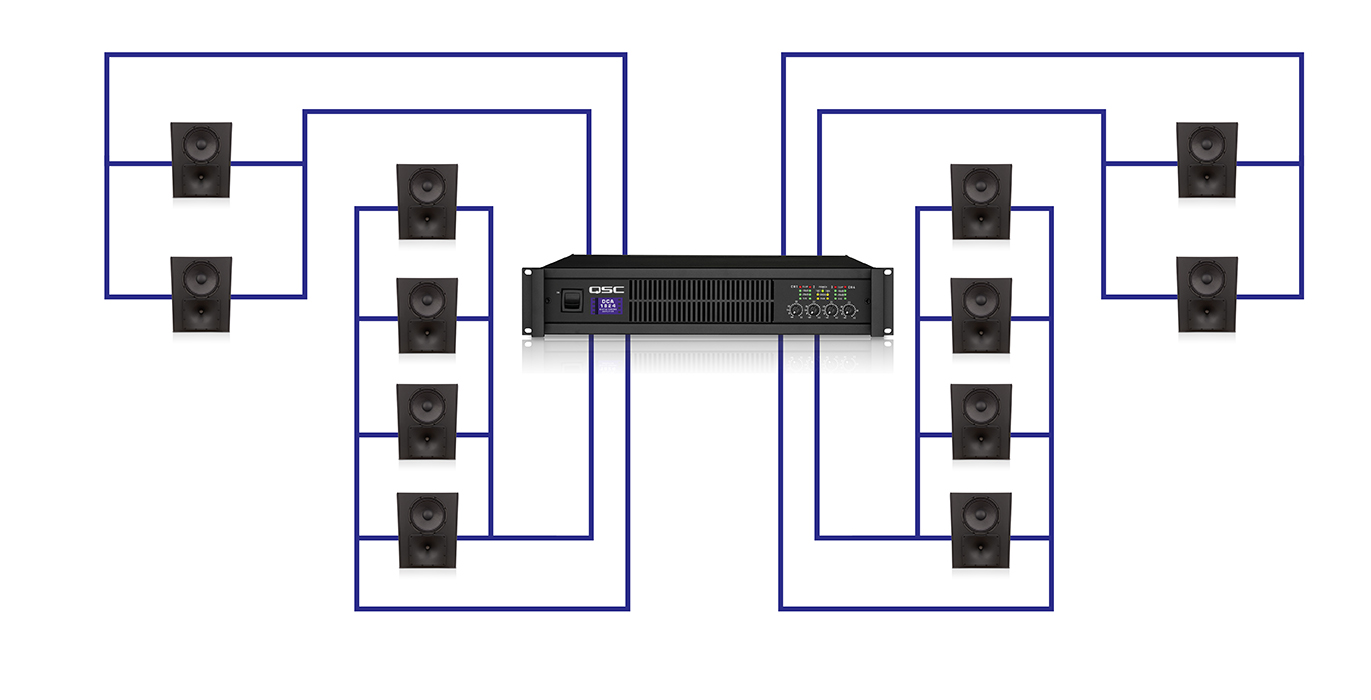
Easier Wiring
Wiring surround speakers in parallel is easy and intuitive. All of the connections are made in the same polarity. All “+” terminals from the speakers connect to the “+” terminal of the amp and the same applies to the “-“ terminals. With a series-parallel connection, the “+” terminal of a series-connected pair is wired to the “-“ terminal of the other speaker. There are many opportunities to get something wrong and have some surround speakers playing out of polarity from the rest. With series-parallel, you also have to decide how to connect the speakers for the optimum load, which varies with the number of speakers. If you wired the DCA 2422 example with two strings of three speakers in parallel on each channel, you would get a 12 ohm load and reduce the peak power per speaker to only 64 watts.
QSC always recommends that “home run” wires to each surround speaker be brought back to the booth or amp rack so that all connections and configuration occurs in one place for easy troubleshooting or future upgrades. There are many “off the shelf” terminal block solutions that make it easy to parallel the surround speaker connections and several companies make and sell dedicated speaker termination panels. Terminal blocks like the one in the picture have jumpers available that make it very easy to connect many speakers to a single amp channel.

If four speakers are wired in parallel, then the jumper is cut to length to parallel five terminals, one for each speaker and one for the amp channel.
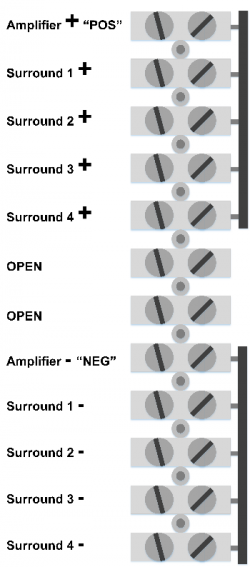
Here are some examples of these terminal strips and jumpers.
One last example of easier wiring: The DCA 1222 2-channel amplifier is specially-designed for extreme low impedance operation and easily solves the odd speaker count problem. It is capable of driving up to five 8-ohm speakers per channel for a combined impedance of only 1.6 ohms. The DC rail voltages are identical to the DCA 1824, so the same dynamic power of 253W per speaker is possible. We’ve found that many 5.1 rooms use 10 surrounds requiring five speakers per channel – four per side wall and two on the rear. There is no series-parallel combination that delivers the same power to all speakers with five speakers per channel, and we’ve already talked about the impedance problems with using an 8-ohm load resistor in series with a speaker. With the DCA 1222, the solution is easy – simply wire five speakers in parallel on each channel.
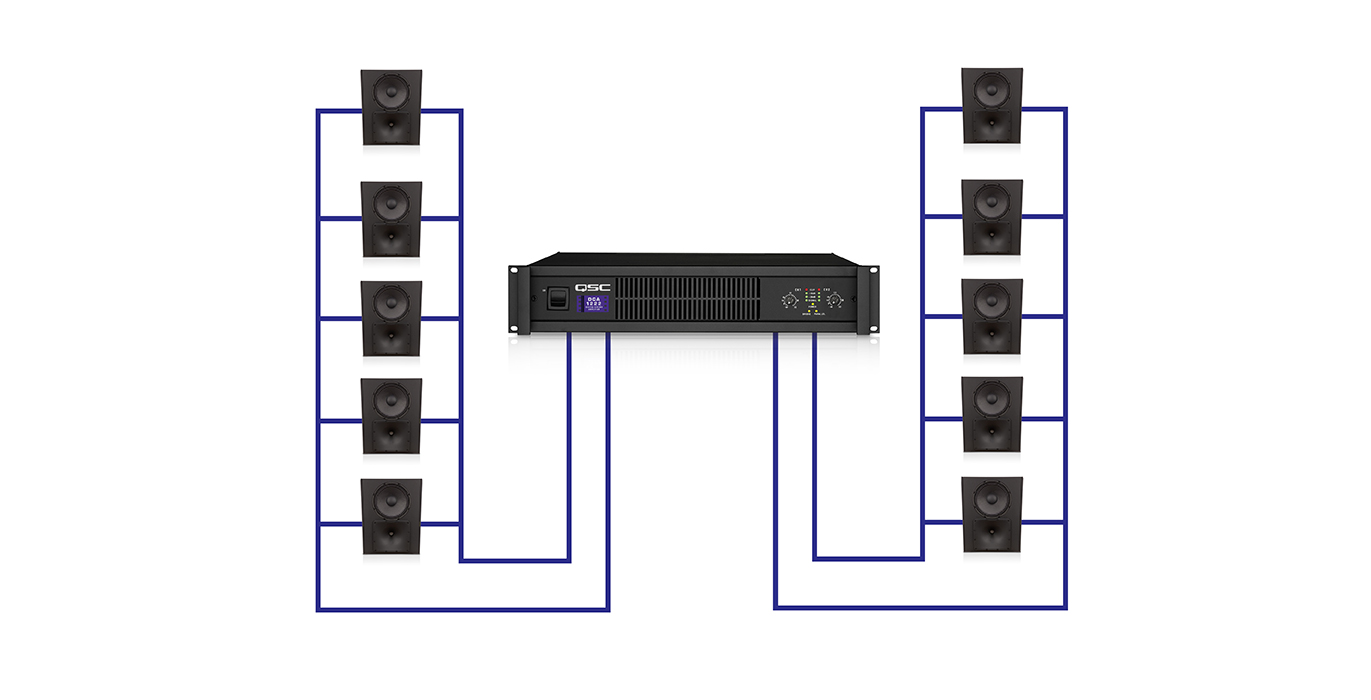
As always, QSC Application Engineers are available to answer specific questions you may have about your system needs. If you have any concerns about your system configuration, it is always a good idea to check with us before ordering and installing amps and speakers. We’re happy to help.
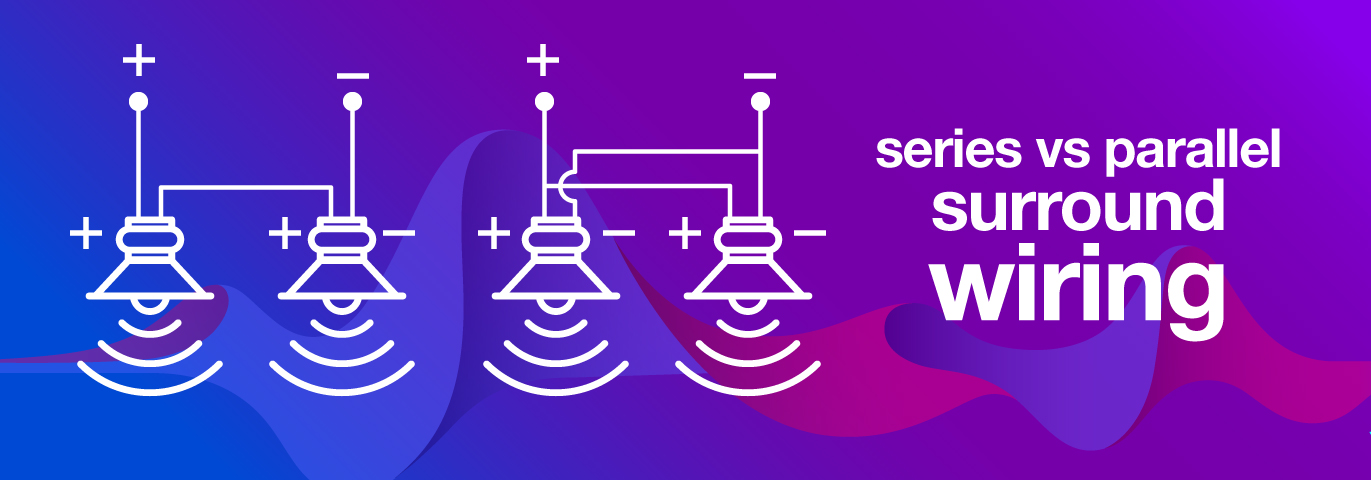
I have a QSC 3400 power amp. I am driving one of each new JBL 2268 18inch subs at 8 ohms on either side. Is it better to run both 8 ohm speakers in parallel to 4 ohms and run the amp in bridge mode to get more power to them. At 8 ohms and one speaker on each side of amp doesn’t seem to have much power for each speaker